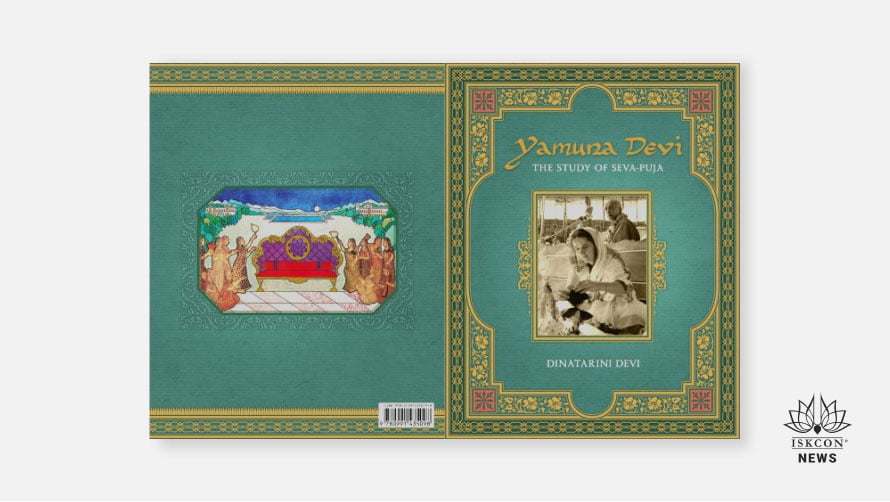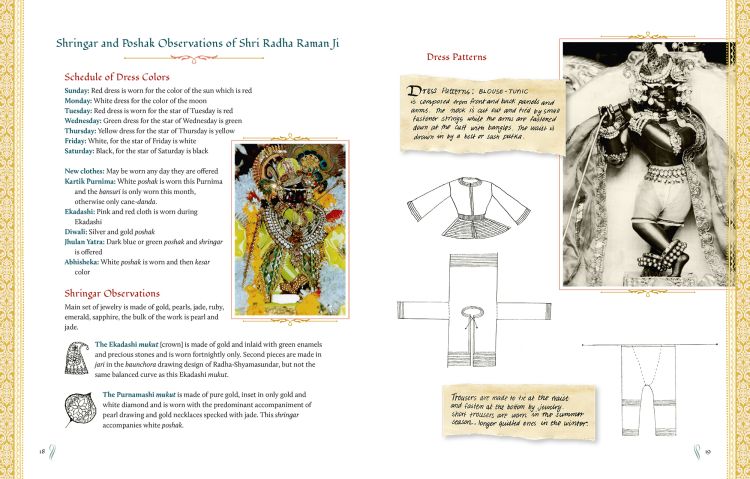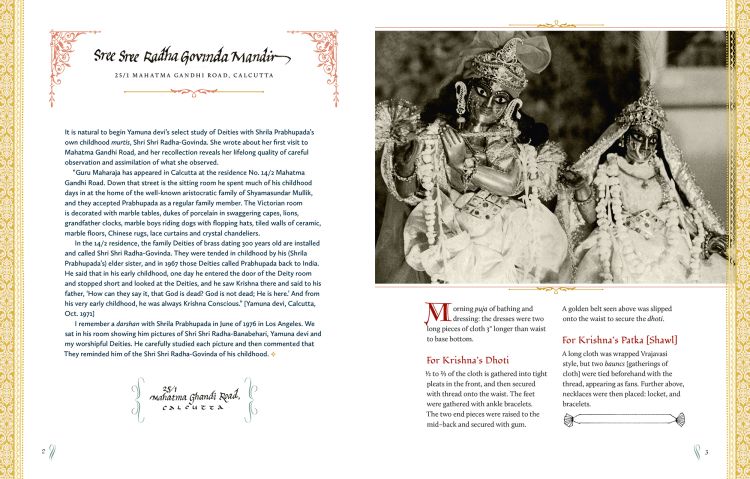New Book Explores Yamuna Devi’s Study of Seva Puja
By Madhava Smullen | Окт 09, 2021

The long-awaited new book, “Yamuna Devi: The Study of Seva-Puja,” is here. The work presents and expands upon the original “Deity Book,” a parchment-paged binder about deity worship and dress which Yamuna Devi, a much-loved ISKCON pioneer, and early Prabhupada disciple, created and brought with her to each ashram she resided in.
Guests frequently asked her to publish the book, and now, nine years after her passing, Dinatarini Devi, her companion in devotional life for 37 years, has compiled Yamuna’s work along with fascinating historical details about her studies in deity worship.
According to the book, Srila Prabhupada began instructing Yamuna in the rudiments of Deity worship, or seva-puja, in 1969 at John Lennon’s Tittenhurst Manor in England. Using his own six-inch Radha Krishna deities, Prabhupada taught her how to bathe, dress, and decorate Them, and how to perform arati. He continued to train her while she traveled with him in India, and in 1971, she began worshiping her first small deities.
In 1972, when Yamuna was given the service of preparing for the deity seva at ISKCON’s upcoming Krishna Balaram Mandir in Vrindavan, Srila Prabhupada asked her to study deity worship standards, dress, and procedures of the Goswami temples in Vrindavan.
She began with Sri Radha Raman Mandir, which Prabhupada had specifically requested her to study due to the excellence and historical consistency of its deity seva standards. Srila Prabhupada had a warm relationship with Radha Ramana sevaite Vishvambhar Goswami who, along with Hari Charan Goswami, Padmanabha Goswami and others, welcomed Yamuna with open arms and gave her access to their schedule of worship, shringar (dress), cooking, bhoga offerings, festivals, and special darshans.
Yamuna took copious and detailed notes and drew illustrations of the deity dresses and ornaments, both at Radha Raman Mandir and the many other temples she studied at in Vrindavan and beyond.

Yamuna Devi’s handwritten notes and drawings on Sri Radha Raman ji’s dress and jewelry
The gorgeously designed book “Yamuna Devi: The Study of Seva-Puja” presents her studies, notes, and illustrations from 1971 to 1974, including excerpts in her handwriting and explanations, along with many photos. There are also introductions to each section by Dinatarini Devi, who gives background history about the various temples and deities, as well as about Yamuna’s time with them. Finally, in the Appendices is a facsimile reproduction of Yamuna Devi’s original deity book. The result will expand readers’ appreciation of deity seva, and take them on a journey into the past, showing them what deity worship and dress at these renowned temples was like in the early 1970s.
In Vrindavan, as well as Sri Radha Raman Mandir, the book covers Yamuna’s studies of seva puja at Sri Sri Radha-Damodar Mandir, where Srila Prabhupada resided for several years before traveling to the West; the Sri Sri Radha-Shyamasundara Mandir of Shyamananda Pandit; the Sri Sri Radha-Madan Mohan Naya Mandir; the Sri Sri Radha-Gokulananda Mandir; and the Sri Sri Radhavallabh Mandir. It also covers Yamuna’s service preparing for deity worship at ISKCON’s under-construction Krishna Balaram Mandir, and Srila Prabhupada’s instructions on the matter.
Outside of Vrindavan, the book covers Yamuna Devi’s study of Sri Sri Radha-Govindadevji and Sri Sri Radha-Gopinath in Jaipur, Rajasthan, both commissioned by Lord Krishna’s great-grandson, Vajranabha, 5,000 years ago.
Then there’s Sri Sri Janaki Valballa Mandir, where Kumar Pratap Singh, the Yuvaraj of Alwar, worshipped Sita-Rama. A former princely state in Rajasthan, Alwar traces its history back to the Matsya kingdom of the Mahabharata, and the Pandavas spent the last year of their exile there. Yamuna first met the Yuvaraj while on sankirtan in the early 1970s, and he became a well-wishing friend and inspiration for her deity seva puja. Yamuna, the book recounts, often spoke of his devotion and the sterling standard of his seva-puja.

From the chapter covering Yamuna Devi’s study of Srila Prabhupada’s childhood deities, Sri Sri Radha Govinda
Meanwhile, the book also covers Yamuna’s study of Srila Prabhupada’s own childhood deities, Sri Sri Radha-Govinda, at 25/1 Mahatma Gandhi Road in Calcutta; Radha-Govinda at Rupa Gaudiya Math in Allabhad; and a number of deities in Mayapur Dham, West Bengal. It even tells the story of how, while visiting the home of a Mr. Balu in Madras, Yamuna was so taken with the beauty of his deity of Srimati Radharani, that she asked the sculptors to take inspiration from Her while sculpting ISKCON Vrindavan’s Srimati Radharani.
It was from these early studies that Yamuna Devi’s lifelong dedication to deity seva-puja grew. In the final part of the book, we see that dedication in action – the text covers the history, worship, and sringar of Sri Sri Radha-Banabehari, Yamuna, and Dinatarini’s worshipable deities since 1975.
“Words cannot describe the joy she felt in Their service,” reads the book’s jacket copy. “Whether planning festivals, designing dresses and jewelry, cleaning, cooking or sewing – she devotedly served Them throughout the remainder of her life. Yamuna devi’s commitment to the highest standards of deity seva-puja is an inspiration for all who aspire to serve the archa-vigraha form of the Lord.”
“I wanted to show Yamuna’s precision, her precise attention to detail in every service that she engaged in for Srila Prabhupada,” Dinatarini says. “For example, if you read her cookbook, you can see how she spent years working on it so carefully. It was the same with everything, including deity worship, and I hope this book illuminates that. I also hope that it enhances readers’ appreciation of deity seva puja, and of the deities discussed within its pages, and Their history.”
Order Yamuna Devi: The Study of Seva-Puja here:
USA: https://krishnamagic.com/order/
India: https://tulsibooks.com/product/yamuna-devi-the-study-of-seva-puja/
Europe: BLS – coming soon
UK: https://krishnashopping.com/products/yamuna-devi-the-study-of-seva-puja
Australia: Vedic Sky – coming soon















